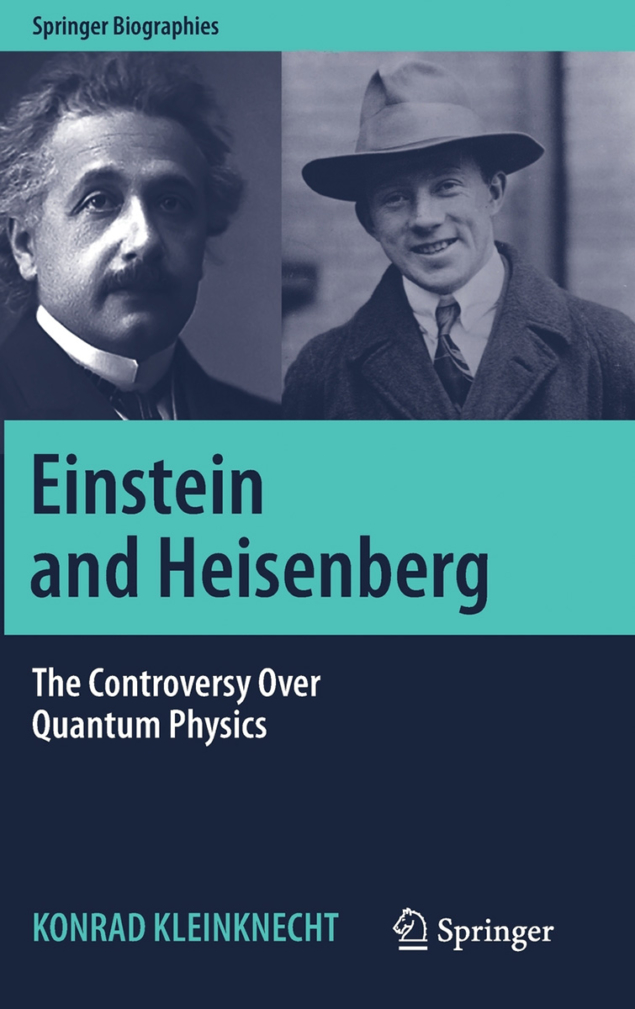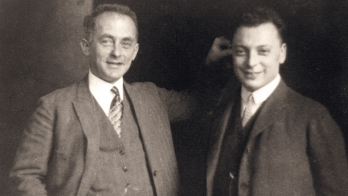Einstein and Heisenberg: The Controversy over Quantum Physics, by Konrad Kleinknecht, Springer

This attractive and exciting book gives easy access to the history of the two main pillars of modern physics of the first half of the 20th century: the theory of relativity and quantum mechanics. The history unfolds along the parallel biographies of the two giants in these fields, Albert Einstein and Werner Heisenberg. It is a fascinating read for everybody interested in the science and culture of their time.
At first sight, one could think that the author presents a twin biography of Einstein and Heisenberg, and that’s all. However, one quickly realises that there is much more to this concise and richly illustrated text. Einstein and Heisenberg’s lives are embedded in the context of their time, with emphasis given to explaining the importance and nature of their interactions with the physicists of rank and name around them. The author cites many examples from letters and documents for both within their respective environments, which are most interesting to read, and illustrate well the spirit of the time. Direct interactions between both heroes of the book were quite sparse though.
At several stages throughout the book, the reader will become familiar with the personal life stories of both protagonists, who were, in spite of some commonalities, very different from each other. Common to both, for instance, was their devotion to music and their early interest and outstanding talent in physics as boys at schools in Munich, but on the contrary they were very different in their relations with family and partners, as the author discusses in a lively way. Many of these aspects are well known, but there are also new facets presented. I liked the way this is done, and, in particular, the author does not shy away from also documenting the perhaps less commendable human aspects, but without judgement, leaving the reader to come to their own conclusion.
Topics covering a broad spectrum are commented on in a special chapter called “Social Affinities”. These include religion, music, the importance of family, and, in the case of Einstein, his relation to his wives and women in general, the way he dealt with his immense public reputation as a super scientist, and also his later years when he could be seen as “scientifically an outsider”. In Heisenberg’s case, one is reminded of his very major contributions to the restoration of scientific research in West Germany and Europe after World War II, not least of course in his crucial founding role in the establishment of CERN.
Do not expect a systematic, comprehensive introduction to relativity and quantum physics; this is not a textbook. Its great value is the captivating way the author illustrates how these great minds formed their respective theories in relation to the physics and academic world of their time. The reader learns not only about Einstein and Heisenberg, but also about many of their contemporary colleagues. A central part in this is the controversy about the interpretation of quantum mechanics among Heisenberg’s colleagues and mentors, such as Schrödinger, Bohr, Pauli, Born and Dirac, to name just a few.
Another aspect of overriding importance for the history of that time was of course the political environment spanning the time from before World War I to after World War II. Both life trajectories were influenced in a major way by these external political and societal factors. The author gives an impressive account of all these aspects, and sheds light on how the pair dealt with these terrible constraints, including their attitudes and roles in the development of nuclear weapons.
A special feature of the book, which will make it interesting to everybody, is the inclusion of various hints as to where relativity and quantum mechanics play a direct role in our daily lives today, as well as in topical contemporary research, such as the recently opened field of gravitational-wave astronomy.
This is an ambitious book, which tells the story of the birth of modern physics in a well-documented and well-illustrated way. The author has managed brilliantly to do this in a serious, but nevertheless entertaining, way, which will make the book a pleasant read for all.







